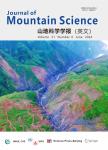Geo-engineering Lessons Learned from the 2008 Wenchuan Earthquake in Sichuan and Their Significance to Reconstruction
Geo-engineering Lessons Learned from the 2008 Wenchuan Earthquake in Sichuan and Their Significance to Reconstruction作者机构:State Key Laboratory of Geohazard Prevention and Geoenvironment Protection Chengdu University of Technology Chengdu 610059 Sichuan China
出 版 物:《Journal of Mountain Science》 (山地科学学报(英文))
年 卷 期:2011年第8卷第2期
页 面:176-189页
核心收录:
学科分类:070801[理学-固体地球物理学] 081803[工学-地质工程] 07[理学] 08[工学] 0708[理学-地球物理学] 0818[工学-地质资源与地质工程]
基 金:supported by the National Basic Research Program of the Ministry of Science and Technology of the People’s Republic of China (973 Project Grant No. 2008CB425801)
主 题:Wenchuan Earthquake Geohazard Reconstruction
摘 要:The 2008 Wenchuan earthquake in Sichuan of China was the result of quake-triggering along an active several hundred-kilometer-long fault. The subsequent landslides and debris flow geohazards are dominating factors in planning post-disaster recovery and rebuilding. This paper presents recommendations for coping with large-scale geohazards and disasters. It is essential to establish a national emergency management system for huge scale catastrophe and earthquake precursor identification. Town construction must be kept away from active faults, especially to improve town safety in areas with high risk of seismic and geological hazards, and it is important to improve geohazard investigation and remediation for mountain areas that have become loosened by earthquake activity. Geological factors must be better understood to reduce direct and secondary risks and effects of earthquakes. Site selections for public relocation require clear and informed analysis of geological and social risk reduction, so that relocation, infrastructure reconstruction, and commemorative relic-sites can be protected.



